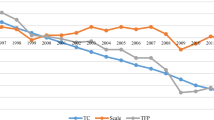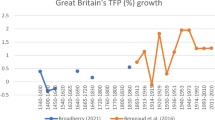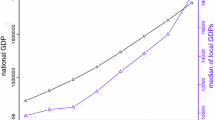Abstract
This paper analyzes the direct and indirect effects of fiscal policy on total factor productivity (TFP) in a panel of OECD countries over the period 1970–2012. Our contribution is twofold. First, when estimating the impact of fiscal policy on TFP from a production function approach, we identify the worldwide available level of technology by exploiting the observed strong cross-sectional dependence between countries instead of using ad hoc proxies for technology. Second, next to direct effects, we allow for indirect effects of fiscal policy by modeling the access of countries to worldwide available technology as a function of fiscal policy and other variables. Empirically, we propose and implement a nonlinear version of the common correlated effects pooled (CCEP) estimator of Pesaran (Econometrica 74(4):967–1012, 2006). The estimation results show that through the direct channel, budget deficits harm TFP. A shift toward productive expenditures has a strong positive impact on TFP, whereas a shift toward social transfers reduces TFP. Through the indirect channel, significant positive effects on a country’s access to global technology come from reducing the statutory corporate tax rate and from reducing barriers to trade.


Similar content being viewed by others
Notes
These authors test the assumption of long-run homogeneity (pooled mean group estimation) versus long-run heterogeneity (mean group estimation) for the impact of fiscal policy variables on growth in a highly similar panel of 17 OECD countries for the period 1970–2004. Their Hausman test implies that the assumption of long-run homogeneity cannot be rejected (see their Table 2).
The selection of countries and time coverage is driven by data availability. The included countries are Australia, Austria, Belgium, Canada, Denmark, Finland, France, Italy, Japan, Netherlands, Norway, Spain, Sweden, UK and the USA.
As an example, consider a government who chooses to lower the effective corporate tax rate. To do that, it has two options: (i) opting for a lower statutory corporate tax rate or (ii) choosing a smaller tax base. Both options will stimulate investment and raise profits. As a consequence, revenues from corporate taxation could rise because of more taxable profits. This means that a lower effective corporate tax rate could result in a higher macro-backward looking indicator.
The overall conclusion that most variables are non-stationary does not change when changing the number of common factors or the specification of the deterministic component.
Note that (Wan (2012), chap. 5) provides some heuristic asymptotic results for a CCEP estimator with nonlinear transformations of \(I(1)\) variables but which is still linear in the coefficients.
Using the PANIC approach to testing for panel cointegration in the presence of common factors has also been suggested by Gengenbach et al. (2006), Banerjee and Carrion-i-Silvestre (2006) and Bai and Carrion-i-Silvestre (2013). The main difference between these approaches and ours lies in the estimation of the unknown coefficients in the cointegrating relation, for which we use the CCEP estimator while the above references estimate a model in first differences with the common factors and factor loadings estimated using principal components.
Since \(\theta =0\) we also have \(\sigma _\varepsilon =0.02\) in this case. As the dependent variable \(\ln Q_{it}\) is log real GDP, \(\sigma _\varepsilon =0.02\) implies that 95 % of the generated error terms \(\varepsilon _{it}\) are between \(-\)4 and 4 % of real GDP.
Simulation results for the CCEP estimator are available on request.
Allowing for more than one common factor in the PANIC cointegration test on the CCEP composite error terms does not yield a different conclusion, i.e., setting \(r=2\) yields \(p\) values for the MW test on \(\widehat{\varepsilon }^{pc}_{it}\) equal to 0.47, 0.48, 0.85 and 0.16 in S1, S2, S3 and S4, respectively.
For a correct interpretation of the results, note that the estimated coefficients are long-run elasticities. They indicate the percentage change in real output associated with a one percentage change in the share of a tax or expenditure category in GDP. To obtain the percentage change in output due to a one percentage point change in a tax or expenditure share, the estimated elasticity should be divided by the level of the tax or expenditure share. We report these shares for our sample in 2012 in “Appendix 1”, where we discuss the construction of the data
References
Acharya R, Keller W (2009) Technology transfer through imports. Can J Econ 42(4):1411–1448
Agell J, Lindh T, Ohlsson H (1997) Growth and the public sector: a critical review essay. Eur J Polit Econ 13:33–52
Agell J, Lindh T, Ohlsson H (1999) Growth and the public sector: a reply. J Polit Econ 15:359–366
Alesina A, Perotti R (1995) Fiscal expansions and adjustments in OECD countries. Econ Policy 21:205–248
Alfaro L, Kalemh-Ozcan S, Volosovych V (2008) Why doesn’t capital flow from rich to poor countries? An empirical investigation. Rev Econ Stat 90(2):347–368
Angelopoulos K, Philippopoulos A, Tsionas E (2008) Does public sector efficiency matter? Revisiting the relation between fiscal size and economic growth in a world sample. Public Choice 137(1–2):245–278
Arjona R, Ladaique M, Pearson M (2003) Growth, inequality and social protection. Can Public Policy 29(S):S119–S139
Arnold J, Brys B, Heady C, Johansson A, Schwellnus C, Vartia L (2011) Tax policy for economic recovery and growth. Econ J 121(550):F59–F80
Backus D, Henriksen E, Storesletten K (2008) Taxes and the global allocation of capital. J Monet Econ 55(1):48–61
Bai J, Carrion-i-Silvestre J (2013) Testing panel cointegration with unobservable dynamic common factors that are correlated with the regressors. Econom J 16:222–249
Bai J, Ng S (2002) Determining the number of factors in approximate factor models. Econometrica 70(1):191–221
Bai JS, Ng S (2004) A PANIC attack on unit roots and cointegration. Econometrica 72(4):1127–1177
Banerjee A, Carrion-i-Silvestre J (2006) Cointegration in panel data with breaks and cross-section dependence. Economics Working Papers ECO2006/5, European University Institute
Banerjee A, Carrion-i-Silvestre J (2011) Testing for panel cointegration using common correlated effects. Technical Report, Department of Economics, University of Birmingham, Discussion Paper 11–16
Barro R, Lee JW (2010) A new data set of educational attainment in the world, 1950–2010. NBER Working Papers 15902
Benassy-Quere A, Fontagne L, Lahreche-Revil A (2005) How does FDI react to corporate taxation? Int Tax Public Financ 12(5):583–603
Berger T, Heylen F (2011) Differences in hours worked in the OECD: institutions or fiscal policies. J Money Credit Bank 43:1333–1369
Bergh A, Henrekson M (2011) Government size and growth: a survey and interpretation of the evidence. J Econ Surv 25(5):872–897
Blankenau W, Simpson N, Tomljanovich M (2007) Public education expenditures, taxation, and growth: linking data to theory. Am Econ Rev 97(2):393–397
Byrne J, Fiess N, Ronald M (2011) The global dimension to fiscal sustainability. J Macroecon 33:137–150
Coakley J, Fuertes A, Smith R (2006) Unobserved heterogeneity in panel time series models. Comput Stat Data Anal 50(9):2361–2380
Coe D, Helpman E (1995) International R&D spillovers. Eur Econ Rev 39(5):859–887
Coe D, Helpman E, Hoffmaister A (2009) International R&D spillovers and institutions. Eur Econ Rev 53(7):723–741
Costantini M, Destefanis S (2009) Cointegration analysis for cross-sectionally dependent panels: the case of regional production functions. Econ Model 26(2):320–327
Costantini M, Demetriades P, James G, Lee K (2013) Financial restraints and private investment: evidence from a nonstationary panel. Econ Inq 51:248–259
Cournède B, Goujard A, Pina A (2013) How to achieve growth- and equity-friendly fiscal consolidation? A proposed methodology for instrument choice with an illustrative application to OECD countries. OECD Economics Department Working Papers 1088, OECD
Devereux M (2007) Developments in the taxation of corporate profit in the OECD since 1965: rates, bases and revenues. Working paper, Oxford University Centre for Business Taxation
Devereux M, Griffith R (2003) Evaluating tax policy for location decisions. Int Tax Public Financ 10(2):107–126
de la Fuente A (1997) Fiscal policy and economic growth in the OECD. CEPR Discussion Papers 1755, C.E.P.R. Discussion Papers
de la Fuente A, Doménech R (2001) Schooling data, technological diffusion and the neoclassical model. Am Econ Rev 91:323–327
de Mooij R, Ederveen S (2003) Taxation and foreign direct investment: a synthesis of empirical research. Int Tax Public Financ 10(6):673–693
Dhont T, Heylen F (2009) Employment and growth in Europe and the US-the role of fiscal policy composition. Oxf Econ Pap 61(3):538–565
Docquier F, Michel P (1999) Education subsidies, social security and growth: the implications of a demographic shock. Scand J Econ 101(3):425–440
Easterly W, Rebelo S (1993) Fiscal policy and economic growth–an empirical investigation. J Monet Econ 32(3):417–458
Eberhardt M, Teal F (2013) No mangoes in the tundra: spatial heterogeneity in agricultural productivity. Oxf Bull Econ Stat 75:914–939
Elliott G, Rothenberg T, Stock J (1996) Efficient tests for an autoregressive unit root. Econometrica 64(4):813–36
Everaert G (2014) A panel analysis of the Fisher effect with an unobserved I(1) world real interest rate. Econ Model 41:198–210
Faria A, Mauro P (2009) Institutions and the external capital structure of countries. J Int Money Financ 28(3):367–391
Ferreira P, Pessoa S (2007) The effects of longevity and distortions on education and retirement. Rev Econ Dyn 10(3):472–493
Fischer S (1993) The role of macroeconomic factors in growth. J Monet Econ 32(3):485–512
Folster S, Henrekson M (1999) Growth and the public sector: a critique of the critics. Eur J Polit Econ 15:337–358
Folster S, Henrekson M (2001) Growth effects of government expenditure and taxation in rich countries. Eur Econ Rev 45(8):1501–1520
Fougère M, Mérette M (1999) Population ageing and economic growth in seven OECD countries. Econ Model 16(3):411–427
Gemmell N, Kneller R, Sanz I (2011) The timing and persistence of fiscal policy impacts on growth: evidence from OECD countries. Econ J 121:F33–F58
Gengenbach C, Palm F, Urbain J (2006) Cointegration testing in panels with common factors. Oxf Bull Econ Stat 68(Suppl.S):683–719
Glomm G, Ravikumar B (1997) Productive government expenditures and long-run growth. J Econ Dyn Control 21(1):183–204
Gonzalez X, Pazo C (2008) Do public subsidies stimulate private R&D spending? Res Policy 37(3):371–389
González A, Teräsvirta T, van Dijk D (2005) Panel smooth transition regression models. Working paper series in economics and finance 604, Stockholm School of Economics
Guellec D, de la Potterie B (2004) From R&D to productivity growth: Do the institutional settings and the source of funds of R&D matter? Oxf Bull Econ Stat 66(3):353–378
Gutierrez L (2006) Panel unit-root tests for cross-sectionally correlated panels: a monte carlo comparison. Oxf Bull Econ Stat 68(4):519–540
Hajkova D, Nicoletti D, Vartia L, Yoo K (2006) Taxation and business environment as drivers of foreign direct investment in OECD countries. OECD Econ Stud 43:7–38
Hansson P, Henrekson M (1994) A new framework for testing the effect of government spending on growth and productivity. Public Choice 81(3–4):381–401
Herce J, Sosvilla-Rivero S, de Lucio J (2001) Growth and the welfare state in the EU: a causality analysis. Public Choice 109(1–2):55–68
Heylen F, Everaert G (2000) Success and failure of fiscal consolidation in the oecd: a multivariate analysis. Public Choice 105(1–2):103–124
Heylen F, Van de Kerckhove R (2013) Employment by age, education, and economic growth: effects of fiscal policy composition in general equilibrium. BE J Macroecon 13(1):49–103
Huang Y (2011) Private investment and financial development in a globalized world. Empir Econ 41:43–56
Kamps C (2006) New estimates of government net capital stocks for 22 OECD countries, 1960–2001. IMF Staff Pap 53(1):120–150
Kao C (1999) Spurious regression and residual-based tests for cointegration in panel data. J Econom 90(1):1–44
Kapetanios G, Pesaran M, Yamagata T (2011) Panels with non-stationary multifactor error structures. J Econom 160(2):326–348
Keller W (2010) International trade, foreign direct investment, and technology spillovers. In: Hall BH, Rosenberg N (eds) Handbook of the economics of innovation, vol 2. North-Holland, chap 19, pp 793–829
Klenow P, Rodriguez-Clare A (1997) The neoclassical revival in growth economics: Has it gone too far? In: NBER Macroeconomics Annual 1997, MIT Press, NBER Macroeconomics annual, vol 12, pp 73+
Kneller R, Bleaney M, Gemmell N (1999) Fiscal policy and growth: evidence from OECD countries. J Public Econ 74(2):171–190
Kumar M, Woo J (2010) Public debt and growth. Working Paper 174, IMF Fiscal Affairs Department
Lindbeck A (2006) Sustainable social spending. Int Tax Public Financ 13(4):303–324
Maddala GS, Wu SW (1999) A comparative study of unit root tests with panel data and a new simple test. Oxf Bull Econ Stat 61:631–652
Madsen J (2007) Technology spillover through trade and tfp convergence: 135 years of evidence for the oecd countries. J Int Econ 72(2):464–480
Moon H, Perron B (2004) Testing for a unit root in panels with dynamic factors. J Econom 122(1):81–126
Moon HR, Perron B (2007) An empirical analysis of nonstationarity in a panel of interest rates with factors. J Appl Econom 22:383–400
Munnell A (1992) Policy watch—infrastructure investment and economic growth. J Econ Perspect 6(4):189–198
Nelson R, Denison E, Sato K, Phelps E (1966) Investment in humans, technological diffusion and economic growth. Am Econ Rev 56(2):69–82
Nijkamp P, Poot J (2004) Meta-analysis of the effect of fiscal policies on long-run growth. Eur J Polit Econ 20:91–124
Palm F, Urbain JP, Wan L (2012) Nonlinear least squares dummy variable estimation for independent co-summable panels with fixed effect. Working paper, Maastricht University
Parente S, Prescott E (2002) Barriers to riches. MIT Press Books, Cambridge
Park J, Phillips P (2001) Nonlinear regressions with integrated time series. Econometrica 69:117–161
Pesaran M (2004) General diagnostic tests for cross section dependence in panels. CESifo Working Paper Series No.1229, CESifo Group Munich
Pesaran M (2006) Estimation and inference in large heterogeneous panels with a multifactor error structure. Econometrica 74(4):967–1012
Pesaran M (2007) A simple panel unit root test in the presence of cross-section dependence. J Appl Econ 22(2):265–312
Phillips P, Moon H (1999) Linear regression limit theory for nonstationary panel data. Econometrica 67(5):1057–1112
Romero-Avila D (2006) Fiscal policies and output in the long run: a panel cointegration approach applied to the OECD. Manch Sch 74(3):360–388
Romero-Avila D, Strauch R (2008) Public finances and long-term growth in Europe: evidence from a panel data analysis. Eur J Polit Econ 24(1):172–191
Saikkonen P, Choi I (2004) Cointegrating smooth transition regressions. Econom Theory 20:301–340
Van Pottelsberghe B, Lichtenberg F (2001) Does foreign direct investment transfer technology across borders? Rev Econ Stat 83(3):490–497
Wan L (2012) Estimation and inference in nonlinear nonstationary panel data models. PhD thesis, Maastricht University
Westerlund J, Edgerton D (2008) A simple test for cointegration in dependent panels with structural breaks. Oxf Bull Econ Stat 70(5):665–704
Zhang J (1995) Social security and endogenous growth. J Public Econ 58(2):185–213
Zhang J, Zhang J (2004) How does social security affect economic growth? Evidence from cross-country data. J Popul Econ 17(3):473–500
Acknowledgments
We thank the associate editor, two anonymous referees, Sarah Balliu, Tim Buyse, Marina Emiris, Maud Nautet, Raf Wouters, Luc Van Meensel, and the members of SHERPPA for constructive comments and discussions during the development of this paper. We acknowledge support from the Flemish government (Steunpunt Fiscaliteit en Begroting - Vlaanderen) and the Belgian Program on Interuniversity Poles of Attraction, initiated by the Belgian State, Federal Office for scientific, technical and cultural affairs, contract UAP No. P 6/07. The computational resources (STEVIN Supercomputer Infrastructure) and services used in this work were kindly provided by Ghent University, the Flemish Supercomputer Center (VSC), the Hercules Foundation and the Flemish Government - department EWI.
Author information
Authors and Affiliations
Corresponding author
Rights and permissions
About this article
Cite this article
Everaert, G., Heylen, F. & Schoonackers, R. Fiscal policy and TFP in the OECD: measuring direct and indirect effects. Empir Econ 49, 605–640 (2015). https://doi.org/10.1007/s00181-014-0872-0
Received:
Accepted:
Published:
Issue Date:
DOI: https://doi.org/10.1007/s00181-014-0872-0




